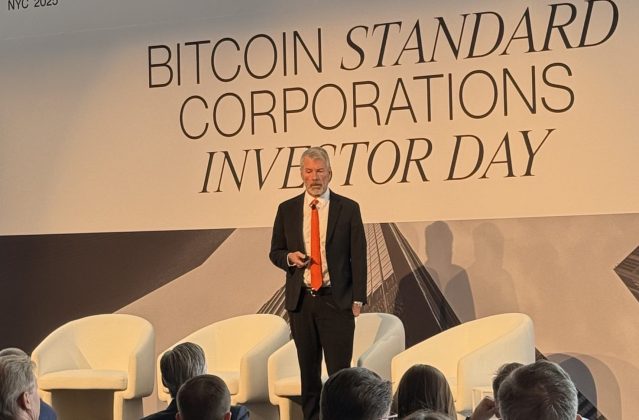Central banks are a fundamental reality of the modern world, but it was not always so. The Bank of England (BoE) was founded in 1694, the first modern central bank. The BoE was born directly from the monetary overreach of the Stuart monarchs. Their military and political ambitions were constrained by the financial power that they could legally wield. The Bank was the end consequence of a series of questionable acts to get their royal hands on the needed money. In that sense, 1600’s England sounds very much like something that bitcoiners and other Fed-watchers would understand.
This essay makes heavy use of “The History of the Bank of England,” by Andreas Andreades, published in 1909, and available online at.1 Andreades is brilliant for clear explanations of financial actions, and their relations to English historical events. A great deal of economic content seems intent on obfuscating concepts which are not inherently complicated. Or avoiding those concepts entirely. See for example the history on the BoE’s website2, which spends at least as much time discussing buildings and architecture as opposed to actual economic history.
It should be noted that Andreades takes an approving stance toward the Bank, related specifically to its military advantage:
“A very slight study of English history shows the importance of this great institution to the Government and to the English nation. The loans made by the Bank to William III and Queen Anne enabled England to regain that position among European nations which she had to all appearances hopelessly lost. The English Government sought help from the Bank on the eve of all the eighteenth century wars.”3
One really fascinating, but unrelated footnote mentioned by Andreades involves the Bank of Genoa. In 1453, the government became so indebted, that several colonies were ceded as payment, and the Bank acquired its own fleet and army for their defense.4 One shudders to imagine Christine Lagarde at the head of an army.
17th Century Europe And England: Catholics And Protestants At Each Others’ Throats
The early 1600’s were a time of religious and political upheaval in Europe. The Holy Roman Empire was disintegrating, and central Europe descended into the Thirty Years War from 1618-1648. Catholics and Protestants fought brutally for control. Entire cities were burnt to the ground. The 50,000-man army of Albrecht von Wallenstein marauded through the continent, plundering any land they conquered.5,6 Europe would not see this level of widespread war and misery again until 1914.
Britain had its own tumult. The famous Guy Fawkes plot of 1605 was made in retribution for James I’s treatment of Catholics. The prior history and the plot itself are explained quite well at.7
James I and his son, Charles I were the first Stuart monarchs. They ruled from 1603-25 and 1625-49, respectively. Both had a fervent belief in the Divine Right of Kings. Charles, though, would especially collide with the worldly realities of implementing his Godly mission.
From the beginning of his rule, Charles clashed with Parliament. Charles could not raise funds for a desired war with Spain, and Parliament subjected his military plans to close, and deserved, scrutiny. In 1629 Charles dissolved Parliament, and ruled as an absolute monarch for 11 years.8
The only problem with Charles’ action was that Parliament was the body with the legal right to raise taxes. Without Parliament, Charles had to become creative to obtain funds. This took the form of “Ship Money”.
Ship Money was an emergency tax for coastal counties to contribute ships, and later money during times of emergency. With no real emergency at hand, Charles manufactured one. The pretext was that pirates – the “terrorists” of their day – were seizing English ships in the Channel. The following year Ship Money was extended to inland counties as well. This measure finally provoked legal challenges, seeing as how it was, in fact, illegal.9
Into this environment, Charles next lobbed the hand grenade of changing the Scottish prayer book to sound more “traditional” – in other words, more Catholic. This provoked the Scots to raise an army and invade the north of England. They captured Newcastle, and, hilariously, they wouldn’t give it back until Charles paid a ransom.10,11
Charles’ response, and his financial desperation, led to the first steps down the path to banks and later, the Bank of England. He sought loans from Spain, the Pope, and from the City of London. When these did not produce the needed funds, Charles made the time-honored choice of debasement, with a plan to lower the quantity of silver in each coin.12
As could be expected, debasement caused the price level to rise 10%. Charles was at his wit’s end. Finally, he simply seized the merchants’ gold. At the time, English merchants stored their gold in the Tower of London. This hoard was too tempting, economic consequences be damned. The seizure caused an immediate uproar from the merchants. Charles ultimately relented, but not before extorting a sizable loan.13
Charles’ troubles would eventually lead to the English Civil Wars, and his own beheading in 1649. But his seizure of merchant gold would begin the transformation of the financial structure of London. Since gold was no longer safe if stored in the Tower, merchants searched for alternate means of storage. This led to the rise of the goldsmiths.
The Goldsmiths
Following Charles and his Divine Right to seize everyone’s money, the merchants first tried holding their gold themselves. However, after enough previously trustworthy employees made off with their boss’ holdings, the merchants turned to the goldsmiths, who enjoyed an impeccable reputation.
At the same time in the 1640’s, the English Civil Wars were raging, with armies for Parliament and the King ravaging the countryside. Landed gentlemen were similarly seeking a safe haven for their stashes. Hence the goldsmiths found themselves in possession of rather tremendous stores of gold. This presented new business opportunities as well as new temptations.14
The first opportunity was obvious for these smiths of gold. The English Mint was not very precise in its manufacture of English coins, which could vary meaningfully in precious content. The goldsmiths would set aside those coins of heavier weight, and export them to foreign markets for profit.15
But the big money would come in the form of loans. The goldsmiths quickly found that they could charge usurious rates of interest by extending credit to merchants with short-term cash flow issues. Next were property owners, who wished to borrow against future rental cash flows. It shortly followed that almost anyone with a future cash flow could borrow against it.
Loan business was booming, and so the goldsmiths sought to expand their deposit base. During the volatile 1640’s, most depositors were happy enough to have safe storage of their assets. But when things settled down, clients demanded interest. The goldsmiths accommodated them, because of the business expansion that it allowed. And the goldsmiths also introduced a shiny new innovation, withdrawal on demand.
Sometime during this time period, goldsmiths started to be called by a new name, Bankers. They had all the main features of modern banks. They paid interest on deposits, and loaned out at a profit. They allowed on-demand withdrawal. And for the last piece, most of their transactions were conducted with receipts, or goldsmith notes. These notes became so widely accepted that they can be called the first banknotes used in England.16
However, with great power comes the opportunity for corruption. Some goldsmiths chased profits over security and went bust, destroying their customer’s money. Some loaned at illegal rates of interest. And since the goldsmiths were amassing ungodly wealth, resentment and ill will necessarily followed.15,17 But the goldsmith Bankers would take things to a new level when they started lending to the government.
Government Loans
By the 1650’s, the goldsmiths held most peoples’ money on deposit, and their loan business was well established. Then a new customer came calling – Oliver Cromwell. Cromwell ruled England as Lord Protector for most of the short-lived English Republic. And he spent a fair portion of his time putting down uprisings, with a formidable standing army. Just as with Charles I, he needed money to pay his soldiers.
Cromwell entered into loans with the goldsmiths on the same terms as merchants and property owners – borrowing against future cash flows. This meant that the goldsmiths gained a legal claim on tax revenues collected by the government.
This practice would expand as soon as the monarchy was restored with the coronation of Charles II in 1660. A first priority was to disband Cromwell’s army, as it might threaten the authority of the King. However, the army first needed to be paid for their service, and for this, a loan was hastily arranged.18
Charles II was known as “The Merry Monarch”, and his reign was relatively peaceful. However he had expensive tastes, and financing from the goldsmiths was readily available. Hence it became regular practice for public finance: Parliament would approve a tax, and immediately Charles would convene the goldsmiths to discuss loan terms.
This started off reasonably enough. The government would pay 8% interest, and the goldsmiths would make a spread over the 6% paid to their depositors.19 But over time, Charles was lured in by easy financing and the ability to spend beyond his means in the present.
The goldsmiths began to charge higher rates, since the taxes pledged as payment grew further and further distant into the future. Some accounts place the government interest rate at 20-30%, while others claim a more reasonable 12%.20
The goldsmiths profited in this way for a time, however in the end Charles defaulted in the same way as anyone else who gets themselves too far into hock. In 1672 Charles attempted to pause all payments to the goldsmiths for one year. When chaos started to ripple through the English economy, a plan was created that was in effect a restructuring. Interest payments were lowered and paused for 6 months, and Charles later granted a yearly rent on some of his land holdings.21
Finally in 1683, all payments to the goldsmiths stopped. Negotiations carried on for 20+ years, and the goldsmiths finally recovered a fraction of their principal.22 In this way, Charles II effectively did the same as his father, Charles I – he appropriated the wealth of his citizens. He just did it in a far more underhanded way.
William Of Orange And The Formation Of The Bank Of England
Following Charles II’s death in 1685, England went through another period of instability. James II took over the throne, and made several moves to Catholicize England. This provoked tremendous resistance, and several Whig and Tory opponents took the extraordinary step to invite William of Orange from the Netherlands to come and take the throne. William was married to English royalty, and he himself was a grandson of Charles I, so there was some claim of royal heritage.23
In 1688, William amassed an impressive fleet, and made the first successful sea invasion of the British Isles since 1066. When William was crowned as King and gained his new country however, he found that the English government was kind of a fixer-upper. Yearly revenues were £1.7MM, of which £1.1MM was immediately spoken for, to pay for a military that was badly in need of repair.24
This was a severe problem. Louis XIV of France was aggressively Catholic, and ambitious, seeking to expand his territory through an ongoing series of wars. William’s chief goal was to counter Louis. New money was needed, and it would not come from the goldsmiths. Parliament didn’t trust William yet, and as such, they only voted in annual taxes that needed to be renewed regularly.
A series of new taxes were introduced, as well as a lottery. By 1694 the government budget had tripled, to £5MM. Such was the cost of proper nation-state competition with France. All the new taxes, however, still produced a shortfall, and the government was in need of £1.2MM.25 There was urgency to find the needed money, because of the ongoing military needs.
For the £1.2MM, a new corporation was proposed, “The Governor and Company of the Bank of England”. Shares in the corporation would be sold to the general public. From this capital, a loan would be made to the government at 8% interest.26
Importantly, the Bank was conceived as a fractional reserve institution. In describing the Bank, early advocate William Paterson says: “… if the proprietors of the Bank can circulate their own fundation of twelve hundred thousand pounds without having more than two or three hundred thousand pounds lying dead at one time with another, this Bank will be in effect as nine hundred thousand pounds or a million of fresh money brought into the nation."27 Thus money creation was seen as a virtue and as an economic stimulant.
The Bank was heatedly debated, with many opposing arguments:28
- The Government would become excessively powerful with this ever-flowing source of funding.
- The Bank would continuously grow until it controlled the commercial sector.
- Because of the high rate of interest, people would simply put money into the Bank rather than investing in trade and industry.
- The Bank would favor certain merchants, who would then have an unfair advantage over their competitors.
Although these arguments have a degree of resonance in the modern world, the Bank was approved by a highly divided Parliament. Passage was in doubt until the last moment, but the Bank passed because of time pressure, the need for money, and the war with Louis.
Despite the doubts expressed by Parliament, shares in the new Bank were successful, and sold out within a very short time. With these shares, a fundamentally new financial product had been created – “the perpetual debt”. Government debt was held as a long-term asset which generated interest. If the holder wanted to recover his principal, then he would simply sell his paper to another investor.
Conclusion
The pre-history of the Bank shows that, at every step, its path was laid by government over-reach and the war machine. Charles I needed money for war, and took several illegal steps to get it, which led to the rise of the goldsmiths. Charles II lived beyond his means, and ultimately appropriated the wealth of his citizens by defaulting on loans owed to the goldsmith. And William needed money to be able to successfully compete with France in the geopolitical arena.
Recalling The Sovereign Individual, it can be seen that central banks are a necessary tool for governments to harness the resources of society for the war machine and nation-state competition – to “increase the returns of violence”.
Bitcoin is the opt-out from this perpetual, tiresome cycle of government theft. Self-sovereign bitcoiners will reduce the pool of resources that governments can harness by force. Geographic mobility will organically give rise to a worldwide community of free men and women innovating and competing peacefully. As we stay humble and stack sats, we will fundamentally alter the landscape of money and power, and point toward a breathtaking future.
This is a guest post by Wilbrrr Wrong. Opinions expressed are entirely their own and do not necessarily reflect those of BTC Inc or Bitcoin Magazine.
Bibliography
(1) https://archive.org/details/historyofbankofe00andrrich
(2) https://www.bankofengland.co.uk/about/history
(3) ref (1), pages 3-4.
(4) ref (1), pages 78-79.
(5) https://en.wikipedia.org/wiki/Sack_of_Magdeburg
(6) https://en.wikipedia.org/wiki/Albrecht_von_Wallenstein#Thirty_Years'_War
(7) https://www.youtube.com/watch?v=hWZIbnkkI9U
(8) https://thehistoryjar.com/2019/02/11/charles-i-and-his-parliament-1625/
(9) ref (1), pages 15-16.
(10) ref (1), pages 16-17.
(11) https://www.english-heritage.org.uk/visit/london-statues-and-monuments/king-charles-I/
(12) ref (1), pages 17-18.
(13) ref (1), pages 18-19.
(14) ref (1), page 21.
(15) “Mystery of the New-Fashioned Goldsmiths”, anonymous pamphlet published in 1676, available online at https://www.gold.org/sites/default/files/documents/1676.pdf
(16) ref (1), page 23-24.
(17) ref (1), pages 24-25.
(18) ref (1), page 33.
(19) ref (1), pages 33-34.
(20) ref (1), pages 34-35.
(21) ref (1), pages 39-41.
(22) ref (1), page 41.
(23) https://www.youtube.com/watch?v=mypTm0VRF4g
(24) ref (1), page 55.
(25) ref (1), pages 57-59.
(26) ref (1), page 65.
(27) ref (1), pages 66-67.
(28) ref (1), pages 67-69.











